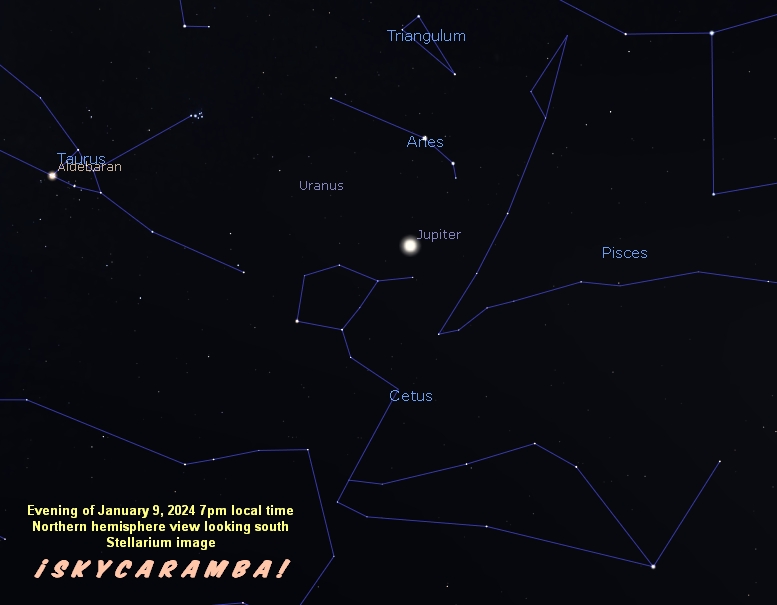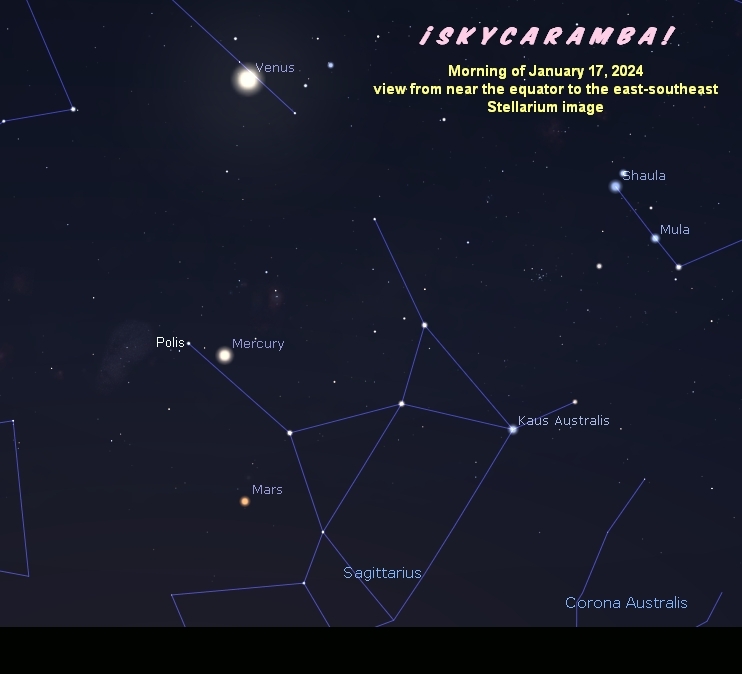We start a new year with Saturn setting in the evening, Jupiter and Uranus setting around midnight, and three other planets rising in the dawn. You can watch Saturn setting earlier each evening this month, even though it’s moving eastward among the stars of Aquarius. It slowly approaches Sigma Aquarii for a close call at the end of this month.

Jupiter and Uranus are both near Cetus the sea monster’s head. Both have been retrograde for a while. Jupiter resumes direct motion as the month begins. Uranus goes direct, or prograde, again as January ends.

Mars, Mercury, and Venus traipse across the teapot dome of Sagittarius this month. They don’t all start January in the constellation. Mars is in Sagittarius on New Year’s Day. Mercury is a little west of it at the southern end of Ophiuchus. Venus is farther east at the north end of Scorpius near the star Acrab. Venus is heading eastward. So is Mars. Mercury is holding still, at first. But just a few days into the new year, it goes eastward too. It picks up the pace. By around the 10th, all three planets seem to be moving at the same speed eastward. Mercury’s greatest elongation on the 12th is 23.5 degrees west of the sun.

Mars passes near Kaus Borealis in Sagittarius on the 12th. By that time, Mercury is within the constellation’s borders and Venus is well into the southern end of Ophiuchus. On the 17th, you can see Mercury apparently close to a very far away star, Polis. The star is believed to be about 29,500 light years away and maybe farther. But because it shines with some 2,000,000 times the sun’s brilliance, it’s a magnitude 3.8 object in our sky—visible with the naked eye if your sky is dark enough. Mercury speeds up a bit with Venus in hot pursuit. All three planets are within the Sagittarius boundaries by the 21st.

Venus is close to Polis on the 26th. And the very next day, Mercury has caught up to Mars. They’re just 0.2 degrees apart. Mercury speeds past Mars after that.

The moon’s at apogee on the 1st. Its distance is 404,800 kilometers. It crosses the equator going south on the 3rd and is at last quarter on the 4th. From the 4th to the 5th, it’ll pass Spica in Virgo. Before the moon passes north of Antares on the 8th, some people will get to see it pass in front of Al Niyat. The moon will pass 5.6 degrees from Venus a little later that day, so this month’s Venus-moon pairing isn’t particularly close. But it does come with those other planets nearby. The moon will be 6.6 degrees from Mercury on the 9th and 4.2 degrees from Mars on the 10th. Also on the 10th, the moon’s at southern lunistice, 28.2 degrees from the equator.

New moon is on the 11th. The moon emerges into the evening sky and passes by Saturn on the 14th, a day after a perigee at 362,300 kilometers distance. The moon goes north over the equator on the 16th. First quarter is on the 18th. The same day, the moon will appear close to Jupiter. It’ll have a conjunction with Uranus on the 19th.

Some viewers will see the moon occult some stars in the Pleiades on the 20th. Northern lunistice is on the 23rd at 28.2 degrees. After passing close to Pollux on the 24th, the moon’s full on the 25th. After a close call with Regulus on the 27th, the moon has another apogee on the 29th. The distance is 405,700 kilometers. And the moon’s southward over the equator again on the 30th.

Earth is at perihelion on the 3rd. Its distance is 147 million kilometers from the sun.
Meteor shower possibilities this month include the far northerly Quadrantids, whose likely peak is on the 4th.
